The legal wife of Casimir the Great, Adelaide, was still alive, but this did not stop the king from standing on the wedding carpet again. He entered into two consecutive marriages, impossibly confusing his family and political situation. Meanwhile, filled with a desire for revenge, Adelaide Heska did everything to humiliate the Polish monarch.
Casimir the Great thought about the rest. Seduced by a voluptuous townswoman, Krystyna Rokiczana, who substituted for him by the Czechs , expelled his legal wife and entered into a bigamistic marriage. He fell down on the Pope, made a laughingstock of himself and did a great deal to harm the Polish kingdom. When he finally freed himself from the influence of his illegal wife and a Czech agent , the situation was critical.
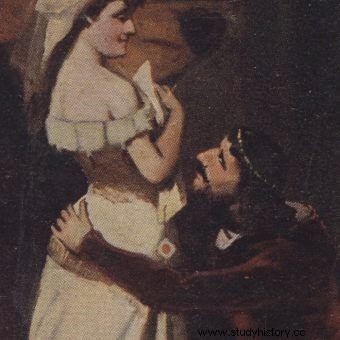
King Kazimierz with one of his lovers, in the image of Jan Moniuszko. Picture from the first half of the 20th century
The earlier (and the only one in the light of church law), the king's wife, Adelaide Heska, did not intend to weaken the pressure on Kazimierz. Consequently, for many years she inhibited all attempts to annul her wedding with Kazimierz in Avignon, i.e. the temporary seat of the papacy. The first pope to whom she brought her supplications - Innocent VI - writhed like an eagle-ower, so as not to make a final judgment. In 1362, however, he died after a serious illness, and Urban V sat on the throne of Peter.
Until then, this Frenchman was the abbot of the monastery in Marseille. He did not have the rank of cardinal, so he did not take part in the conclave. At that time, he was not even near Avignon, because he was traveling around Italy. The escapade should be considered symptomatic, because Urban had one desire within him from the moment of his choice. He dreamed of the papacy returning to Rome. He could not bring the mission to its destination by himself, but on the imperial throne sat a man known for fulfilling wishes. Just as Charles IV of Luxembourg had helped Casimir twice in choosing a new wife, so now - he promised that he would personally escort Urban to the city on the Tiber.
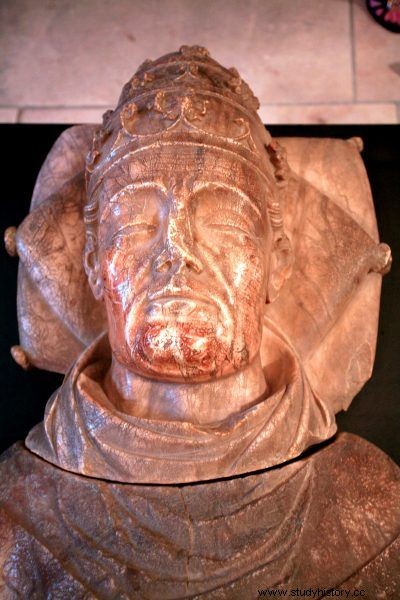
Statue of Urban V, Avignon.
The pope's power in Italy will prove to be very fleeting, and Urban will withdraw from the See of Peter as soon as the imperial reinforcements leave him, but in the meantime he will positively consider a number of pleas from the Prague court. Manor, which for many years, cunningly, dirty in the personal life of the Polish king, doing everything to make him lose the chance of obtaining legal offspring and extending the family.
Pope too pious
Urban V is said to be a rare case of a truly pious pope at this time. He was "a man of extraordinary meticulousness, a learned and perhaps the most spiritual of the Avignon saints." As a known rigor, it was easier for him to pass sentences in a marriage dispute between the Polish king and the exiled queen. Not only did he fulfill the wishes of the Luxembourgs, but he also acted in harmony with his own moral compass. Already in 1363 he sent three bulls - to Kazimierz, Adelaide and to the father of the dismissed queen, Prince of Hesse Henryk Żelazny.
In a letter addressed to the former ruler, we read that the pope only "now learned with dissatisfaction that she had been separated for a long time after living together with Kazimierz, his spouse". Urban expressed the hope that, thanks to the "quick and good will of the king," Adelaide would soon be "restored to this life".
He called on the woman to show "humbly the submission, obedience and respect due to the king, to make sure that she is obliged to win him over with affection," and to make sure that "all quarrels between him and her relatives are completely eradicated. and no more came into being. ”
The pope wrote to Casimir, in turn, to take this humble partner back home and to bed as soon as possible. Perhaps because of a certain naiveté inherent in a novice, or perhaps following a Czech suggestion, he emphasized that this should be done to suppress the scandal that had arisen. And ... to ensure that the king will have legal offspring, which should be born to him by Adelaide. A woman well known to be sterile and unable to bear children.
Truth inquiry
It was not a final verdict, but only one of the first steps in the trial - an attempt at an amicable reconciliation of the parties. Reconciliation, of course, did not take place. Adelaide did not intend to show humility, and Kazimierz did not intend to return to a relationship with a woman whom he had completely alienated himself and who could not extend his family. Both sides dug into their positions. The expelled queen benefited more and more openly from Czech support. The king, in turn, crouched down to the Pope and complied with his every whim.
He even sent Polish troops to Italy to fight the condottiers occupying the Holy Father's estates. In return, Urban agreed to establish a university in Krakow and granted Kazimierz some minor privileges. But he didn't step down on the divorce case.
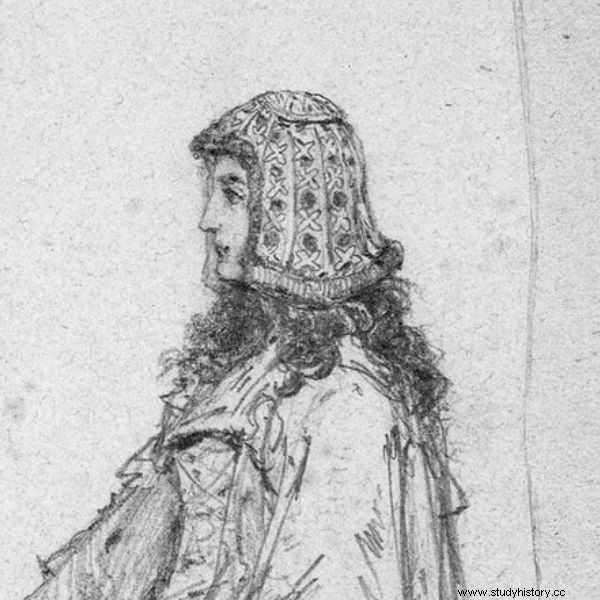
Adelajda Heska, image by Jan Matejko (photo:public domain)
The trial, like almost everyone before the papal court, was protracted and generated costs. The interests of the monarch in the curia were represented by his deputy chancellor, Jan from Busko. The clerk was considered a great flatterer and negotiator. The fact that he knew how to fight for his own good is evidenced by the pope's letter, in which the pope assures the king that he has found a man who is too zealous. However, even the greatest diplomatic talent was not enough to confront the emperor's interests. Months passed, and more and more accusations were made against Jan of Busk.
It was said in Poland that he was a lazy failure. It was even implied that he was acting with ill will and was either bribed by enemies or blackmailed. The king listened to the rumors and waited for any good news. When these still did not come, he was irritated and ordered the sub-chancellor to be taken from Jan from Busko. The ground was burning under the negotiator's feet. The clerk knew that if his work did not show up quickly, he could even face a high treason trial.
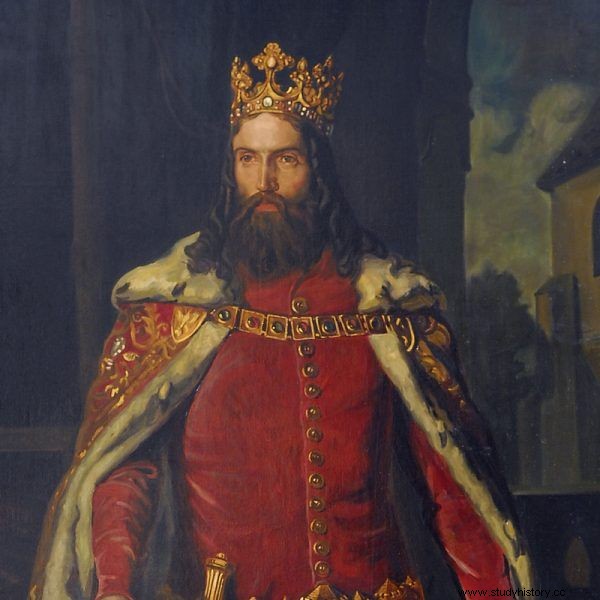
Casimir the Great in the painting by Leopold Löffler.
Desperate, he opened the pannier wider and began to bribe anyone in his path. Finally he returned to the country with a papal dispensation dissolving the old marriage and giving the king the right to remarry.
Up to four times a piece
Kazimierz had everything arranged. In 1365, he was fifty-five and had no time to waste. If he still wanted to father and raise a son, he had to act immediately. The charm of Rokiczany, under which the king had been for the last few years, was broken. The sobered ruler came into contact with the Silesian Piast, Henryk from Żagań. He wanted the prince to give him for a wife the younger of his two daughters, Jadwiga.

A nineteenth-century image of Henryk Żelazny, Duke of Żagań.
The girl was fourteen or fifteen at the most. She was healthy, strong, and too young to manipulate her husband. For Kazimierz, she seemed to be an ideal candidate for a new queen. However, the father was not so sure that a wedding with the Polish monarch was the best that could happen to his child. Everybody knew that the lord of Krakow despises women, does not allow his wives to speak and changes them like gloves. There was also no denying that was a bigamist and that the young Jadwiga Żagańska was threatened with the status of a mistress, not a queen.
Prince Henry would not have agreed to a similar disgrace. A wedding could only take place with the appropriate dispensation. And then Henryk bowed only because he dreamed that his grandson would soon sit on the Polish throne.
A short lie has legs
Not counting the wedding with Aldona Anna Giedyminówna at the behest of her father , it was Kazimierz's first and only marriage without consulting the Luxemburgs, or even against their interests. The wedding took place on February 25, 1365 in Wschowa, so right next to the border between the Polish kingdom and the Żagań state. The wedding was probably not particularly grand, although there is a letter confirming that musicians played and that ... they were late paying for the performance.
From Wschowa, the young couple went to Żarnowiec. For Adelaide, kept locked up here for almost two years before she was expelled from the country It was a gloomy prison fortress, but for Kazimierz and Jadwiga the castle in Żarnowiec was to become a love nest. Here the spouses spent several months making all necessary efforts for the young lady to become pregnant. Probably in the fall of 1365, the belly of the teenage queen did indeed begin to round. Then, however, a thunderbolt struck from the blue. Pope Urban V sent a new bull, announcing that there had been a forgery. And that, contrary to the declarations made to the left and right by the Polish king, he never consented to his new marriage.
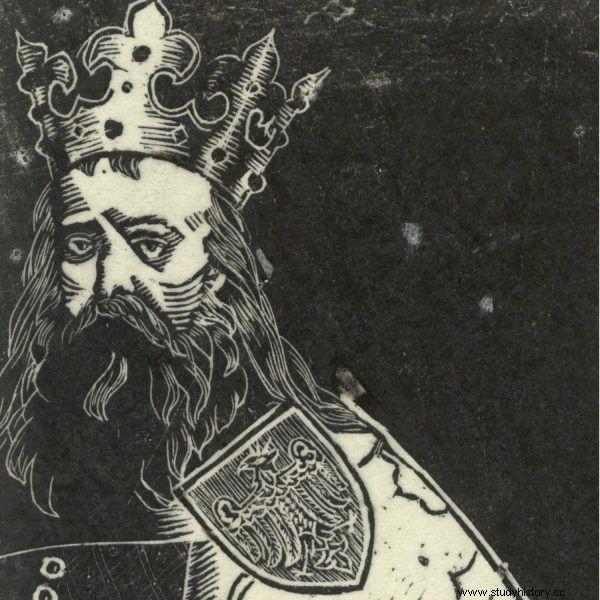
Portrait of Casimir the Great made by Tadeusz Cieślewski according to the pattern of Jan Matejko. 1924
It turned out that, terrified by the vision of his own fall, Jan of Busko was willing to buy a dispensation from anyone. The Pope did not want to give it to him, so the man bribed officials working in the Avignon curial office. He was issued with a document that had all the signs of authenticity, but one that the Holy Father had never even seen with his eyes. Perhaps he was also assured that the matter would be quickly covered up, and that the appropriate people would obtain official, unquestionable consent from Urban. This, of course, never happened.
Jan from Busko, once generously rewarded for his efforts, has now lost almost all prebends and positions again. Kazimierz meanwhile, he was faced with accusations not only of bigamy (and double bigamy!), but also of forgery and insulting the papal majesty.
Selected bibliography:
The article was based on materials collected by the author during the work on the book "Ladies of the Polish Empire. The Women Who Built a Power " . Some of these items are shown below. Full bibliography in the book.
- Dąbrowski J., Casimir the Great, the creator of the Crown of the Kingdom of Poland , Ossolineum, Krakow 1964.
- Jasiński K., Marriages and political connections of Kazimierz Wielki , "Studia Źródłoznawcze", vol. 32–33 (1990).
- Kaczmarczyk Z., Casimir the Great (1333–1370) , S. Arcta Publishing House, Warsaw 1948.
- Kiryk F., The Great King and His Successor , National Publishing Agency 1992.
- Krzyżanowski S., Casimir the Great's legation to Avignon and the first university privileges , "Czas" Printing House, Krakow 1900.
- Kurtyka J., The reborn kingdom. The monarchy of Władysław Łokietek and Casimir the Great in the light of more recent research , Societas Vistulana, Krakow 2001.
- Sroka S.A., Personal life of Kazimierz Wielki. Sources and the truth [in:] Kazimierz - the Great and famous for his deeds Materials from the scientific session, Nowy Wiśnicz, 14–15 May 2010 , Historia Iagellonica, Krakow 2011.
- Śliwiński J., The marriages of Casimir the Great. A study in the field of morality and ethics of the royal court in Poland in the 14th century , Pedagogical University in Olsztyn, Olsztyn 1987.
- Świeżawski E.S., Esterka and other women of Casimir the Great [in:] the same, Outlines of critical research on history, historiography and mythology , vol. 3, Warsaw 1894.
- Wyrozumski J., Casimir the Great , Ossolineum, Wrocław 2004.
